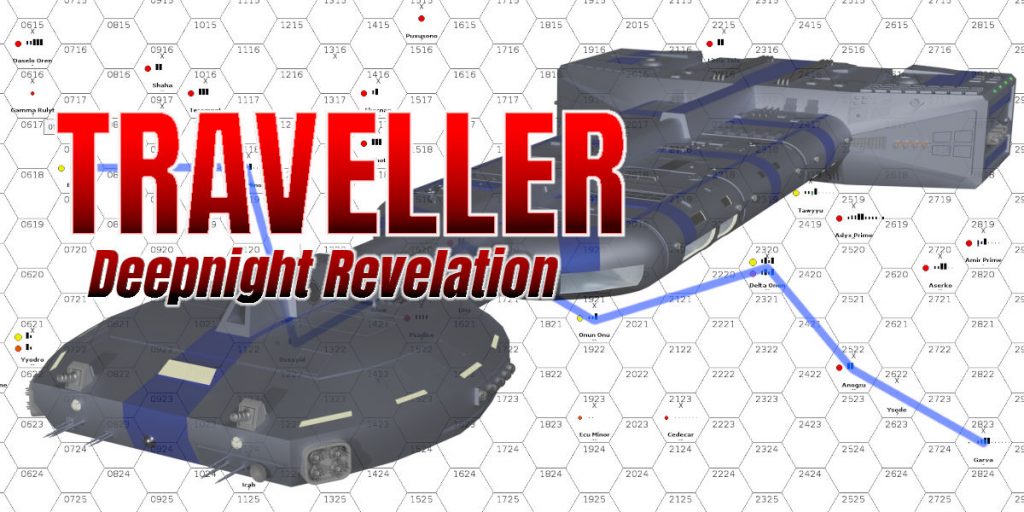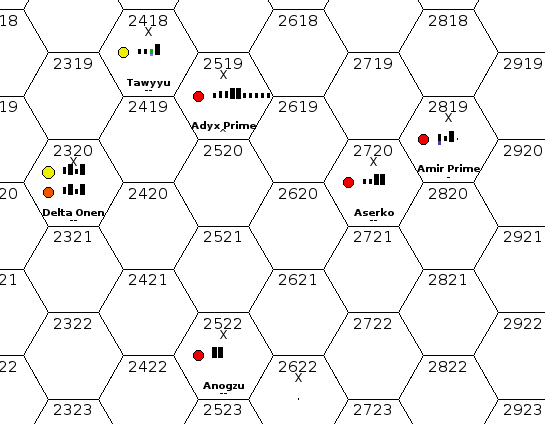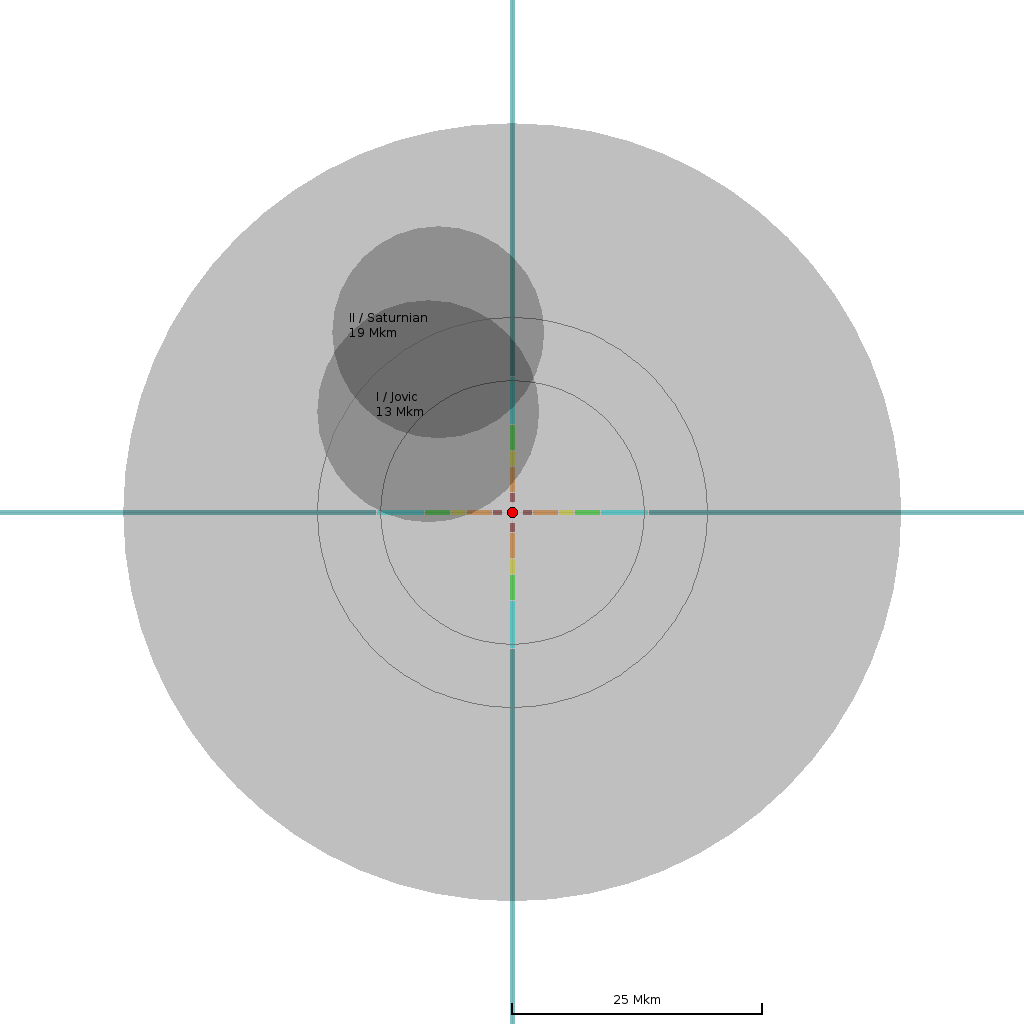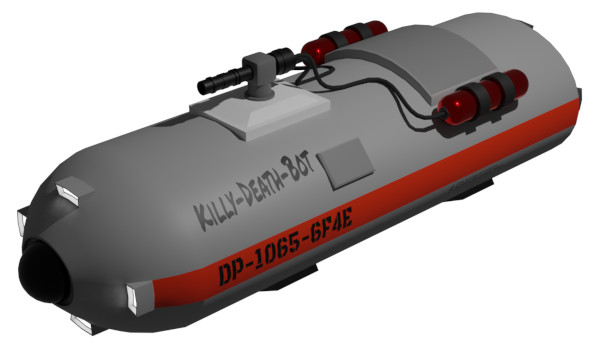Summon Bigger Fish

Leaving behind the ever so useful Traveller Map, all further navigation for my Deepnight campaign will be done using my own mapping software, which isn’t nearly as pretty. It was originally designed to handle all the surveying for the Deepnight campaign, so shows available information on each star system, in terms of number and type of planets.

The star size and colour is shown, and the black bars show the position and size of planets, splitting into categories of dwarf terrestrials, terrestrials and jovians. Those shown in green are possibly life bearing. Those with blue beneath them have water detected. The images aren’t entirely clear, so I may need to do some work improving on that.
Only the planets that the Deepnight has detected are shown. Clicking on them will show more information, again limited by what has so far been detected.

The accuracy of the information improves as the scan value for the system improves. Initially diameters might be accurate to the nearest 50,000km (and anything smaller than 25,000km won’t be detected). But over time more detail will become available.
As it is though, I’m planning to not do the journey star system by star system. I’m going to try to concentrate on the interesting locations and skim over everything else.
This was our first time gaming on Thursday, which complicated things a bit. I have late work meetings on Tuesday, so it normally left a choice of Wednesday or Thursday for any pre-session planning I wanted to do. Gaming on Thursday means I need to get things done by Wednesday.
At the start of the session, I remembered to give everyone some experience when the game started. Since everyone has multiple characters, I gave them 3 xp for one character, 2 for a second and 1 for a third. Their choice on which character gets what, and how it is spent. I’m using the rules in the Companion for experience. Giving out experience is easier than tracking training during downtime.
I also allowed them to increase the general quality of the crew. Deepnight Revelations has rules (taken more or less from the Naval Campaign sourcebook) for abstracting the quality level of the crew.
Crew Efficiency Index – 7
Department Efficiency Index (Flight) – 8
Department Efficiency Index (Engineering) – 8
Department Efficiency Index (Operations) – 8
Department Efficiency Index (Mission) – 9
I gave them two points to increase them by, and they put by Engineering and Operations. A score of 9 means that they’re going to have a +1 on roles for these departments now.
Leaving Garva-411, they headed to the system of Anogzu. During the jump, some of the NPCs decided to start a Zero-G Racquet Ball tournament, with a plan to have a tournament during each jump whilst things were quieter. Another group decided to start a poker tournament, though the command crew made rules that they couldn’t gamble for shifts or anything else that might affect the running of the ship.
At Anogzu they had an encounter with something at the gas giant:
Several bright lights are seen ahead of the ship, and it isn’t clear what is causing them. They seem to zig-zag in front of the ship, then keep on diving off to one side. They may be trying to guide the ship away from danger, or towards it.
After a few more jumps (during which time they noticed that the 3D printers were running low on plastic) the ship eventually reached Isithe at 1619. This system consisted of a single star and two gas giants – but pretty much nothing else. The usual array of dust and comets wasn’t present. It was almost as if the system had been deliberately cleared out.

Approaching the outer gas giant, it had a single moon and a narrow ice ring. The moon was a Europan class world with a liquid water ocean beneath an icy crust. Under the ice, the scans showed that there were some geometric patterns under the ice – a unnaturally regular grid pattern.
Khadashi, Zanobia and others went down in one of the ship’s boats to take a closer look. They melted through most of the ice using their drives, and then a smaller probe (the Killy-Death-Bot) melted its own smaller hole down into the water.

It was dark beneath the ice, but populated with life. Blind, fish-like creatures with long whisker-tentacles swam around in shoals, and were greatly attracted to the much warmer probe. Before it was completely swamped by them, it caught site of a number of cuboid constructions on the under side of the icy crust.
Suddenly something large crashed into the probe, sending it spinning out of control. By the time the remote ops team gained control of it, there were bits of tentacle floating in the water and a discoloration like blood. There was a final sight of the remaining fish rapidly leaving the area, and a much larger creature swimming off into the gloom. The probe had a dent, but was otherwise fine.
The constructions seemed to make up a city, with blocks of buildings and a grid-like pattern of roads running between them. The buildings where up to 15m in size, with circular metre wide holes at the road level. Inside, there were subdivisions in each building. Besides this though, the place seemed deserted. A high level of metals were detected – iron, copper, aluminium etc – but it was still trace amounts.
There were some patterns carved onto the walls of some buildings, but it wasn’t clear whether these were natural or deliberate writing.
Eventually they took some samples and headed back to the Deepnight Revelation.
From Isithe they had a choice whether to detour to a proto-stellar system, and decided to take the chance. It was devoid of large planets (they had enough fuel for a second jump afterwards), but had a few some proto-planetoids, including a proto-gas giant. Again, they took samples and did studies before moving on.
One of their small boats got damaged in the exploration, its main drive system overheating in the hot gas cloud around the T-Tauri star.
Eventually by 1110-210, they reached the system of Esara/0718. Just before coming out of jump, a couple of the crew laid out a huge wargaming diorama in the canteen, with two painted armies of Aslan versus iron age cavalry. The question of what had happened to the 3D printers was answered.
The system of Esara was expected to have planets with water, oxygen and life, and initial scans didn’t disappoint. There were two worlds with water, though the first was primordial. The other had a standard atmosphere and was covered with extensive forests and grasslands. Scans indicated that there was also intelligent life here – possibly bronze age city states along some of the river valleys.
This would be an opportunity for both resupply and first contact.
1 Response